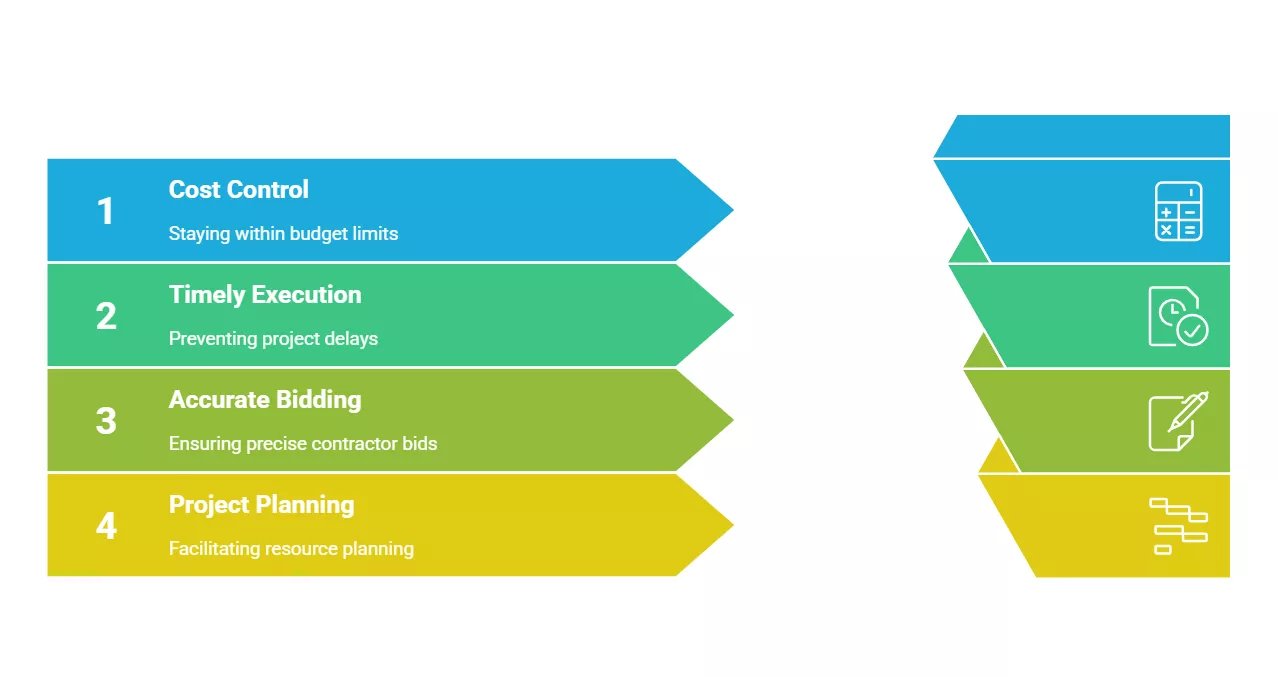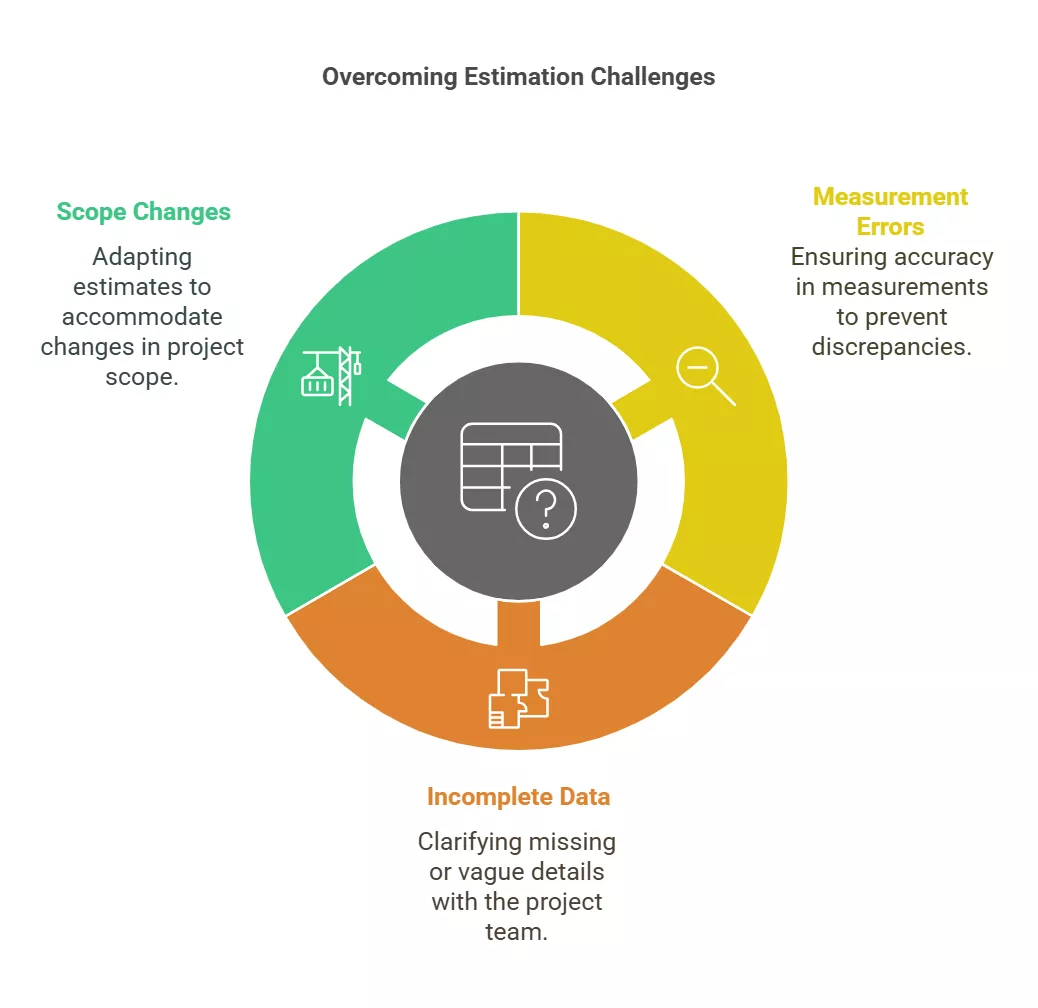Ranked #1 in Accurate and Reliable Estimation Services
A Fastest Turnaround 24 Hours!
Ranked #1 in Accurate and Reliable Estimation Services
A Fastest Turnaround 24 Hours!
Ranked #1 in Accurate and Reliable Estimation Services
A Fastest Turnaround 24 Hours!
Ranked #1 in Accurate and Reliable Estimation Services
A Fastest Turnaround 24 Hours!

In construction work, one of the key steps to any project is performing a takeoff which requires estimation of necessary materials, labor, and equipment based on the specific plan. This step is one of the foremost steps if cost estimates, deadlines, and precise resource allocation are the goals. And for those in the contracting, estimating, or management side of the project, knowing how to perform quantity takeoffs is an imperative skill.
In this guide, we’ll assist you in completing a quantity takeoff by providing useful advice pre and post takeoff.
A construction quantity takeoff is the step in construction estimating when a contractor estimates the materials, labor, and equipment needed to complete a project. This cost estimation is done by measuring every part or element of the construction, for instance, the dimensions of each room, the materials that will be required for the portions, and how much work will have to be done. Accuracy is critical to takeoffs because the estimation will determine how the planning and budgeting will be allocated.
If you’re new to this concept and want to learn more about the basics and importance of quantity takeoffs in construction, check out this detailed guide on what a quantity takeoff is.
Getting a quantity takeoff right can make or break a project. Here’s why it’s so important:

Before you dive into the details of the takeoff, it’s important to set yourself up for success. Here’s what you need to do first:
The given documents shall be referred to as the “scope of works” document for this example. The given documents shall be referred to as the “scope of works” document for this example. Study the blueprints, sketches, and details thoroughly to prepare properly. These documents will enable you to analyze the nature of the work and the corresponding materials necessary for its completion. Keep in mind that special materials, custom structures, and elaborate designs which may require enhanced supervision need to be checked.
Next, decide on the units you’ll use for your measurements. The most common units include:
Choosing the right units ensures your calculations will be accurate and consistent across the project.
While you can still perform a quantity takeoff manually with a tape measure and calculator, most professionals now use software for faster, more accurate results. Some popular tools include:
These tools allow you to measure directly from digital blueprints, saving time and reducing errors.
Now that you’re prepared, let’s break down the process of performing a quantity takeoff. We’ll cover each step, so you don’t miss anything important.
Start by researching the project’s plans and specifications. Such plans include relevant dimensions, required materials, and details of the work scope.
Analyze material and layout specifications to locate floor plans, elevations, and sections. Also, take note of structural materials specified such as concrete, drywall, and roof. This also includes estimating special features that may increase the amount of required materials such as complicated designs or elaborate building methods.
It’s best to divide the project into smaller parts for easier calculations. For example:
Breaking down the project into sections allows you to focus on each area in detail and makes the takeoff more manageable.
Once you have everything divided into sections, it’s time to measure and calculate the quantities of materials, labor, and equipment. Here’s how:
Once you’ve gathered all your measurements, it’s time to organize the data. Use a spreadsheet or specialized software to keep track of your findings. Break down the materials by category (concrete, wood, drywall, etc.) and list the labor and equipment needed for each section of the project.
Keep the data well-organized, as you’ll need to refer back to it throughout the project.
Even experienced estimators face challenges when performing a quantity takeoff. Here are some common issues and tips for overcoming them:
A small mistake in measurements can lead to big discrepancies. To avoid this:
Sometimes, plans don’t include all the details, or some information is unclear. If you run into this issue, don’t hesitate to reach out to the project team. Clarify any missing or vague details before moving forward.
Scope changes during construction can affect your original takeoff. Be ready to update your quantities as changes occur. It’s important to stay flexible and adjust your estimates as needed.

Here are some tips to make your quantity takeoffs even more accurate:
Any construction project involves a vital aspect, which is performing a quantity take off. It aids in making sure the project budget, timeline, and allocated resources are within acceptable standards. This guide is aimed at helping you complete a construction project quantity takeoff with confidence.
As a word of caution, precision matters a lot – whether it be an estimate for materials, labor, or equipment. For your own good, verify your calculations and divide the job into workable sections. You will improve as time goes on, and the job will get easier as you become more proficient at it.
0 Comments